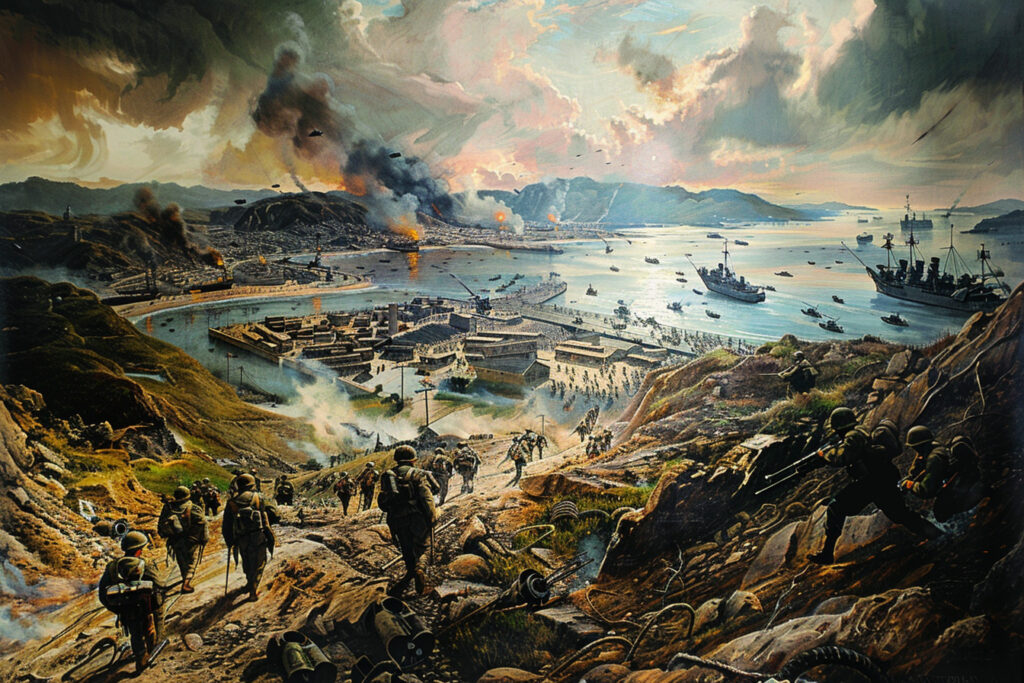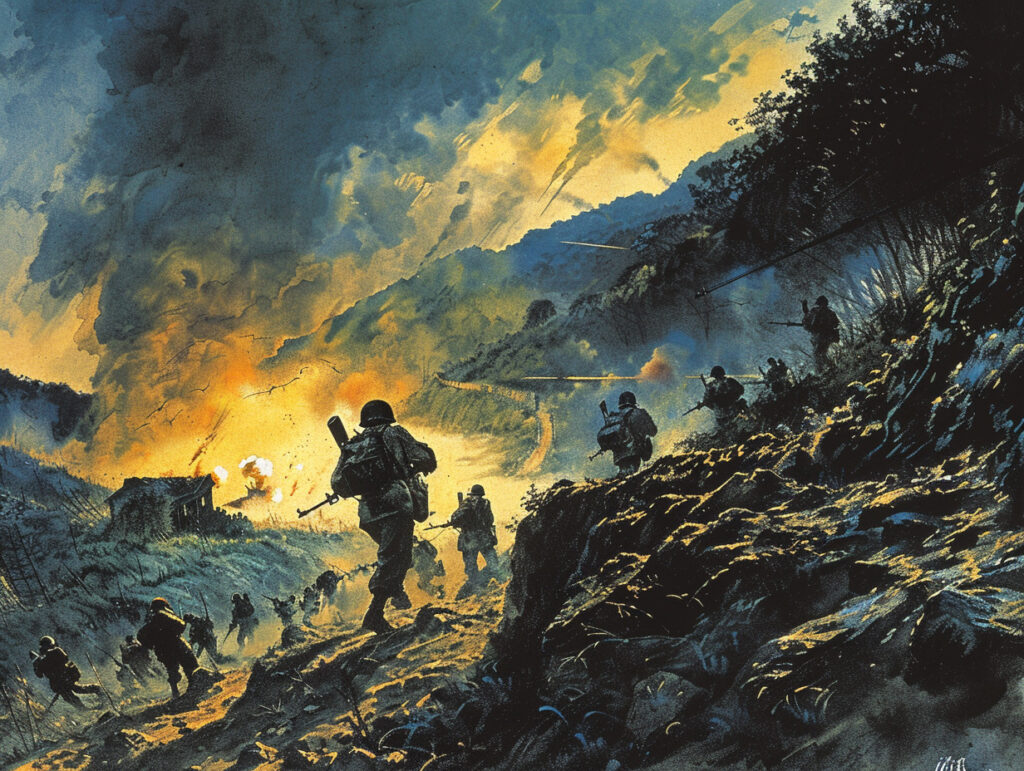The Korean War (1950-1953) was a conflict between North and South Korea, involving major world powers, resulting in significant geopolitical shifts.
The Korean War (1950-1953) was a pivotal conflict that pitted North Korea, backed by China and the Soviet Union, against South Korea, supported primarily by the United States and other United Nations members. This war, occurring in the early stages of the Cold War, had profound implications for global politics and the Korean Peninsula, leading to a heavily militarized border and enduring tensions that continue to this day.
What Were the Reasons for the Korean War (1950-1953)
The origins of the Korean War are deeply rooted in the aftermath of World War II and the emerging Cold War tensions between the United States and the Soviet Union. Korea, which had been under Japanese occupation since 1910, was liberated in 1945. However, the peninsula was divided along the 38th parallel into two zones of occupation: the Soviet Union occupied the north, and the United States occupied the south.
This division was meant to be temporary, but the onset of the Cold War cemented it into a more permanent separation. In the north, Kim Il-sung, supported by the Soviet Union, established a communist government, while in the south, Syngman Rhee, backed by the United States, led a capitalist regime. Both leaders aspired to unify Korea under their respective governments, leading to increasing tensions and border skirmishes.
The ideological clash between communism and capitalism, embodied in the two Korean states, was exacerbated by international politics. The success of the communist revolution in China in 1949 and the Soviet Union’s successful test of a nuclear bomb heightened the sense of a global communist threat in the West. Consequently, the U.S. adopted a policy of containment, aiming to prevent the spread of communism, which directly influenced its stance on Korea. These geopolitical factors, combined with mutual antagonism and the desire for unification on both sides of the Korean Peninsula, set the stage for the outbreak of war.

Who Was Involved in the Korean War (1950-1953)
The Korean War involved multiple nations, reflecting the broader Cold War context. The primary belligerents were North Korea, supported by China and the Soviet Union, and South Korea, backed by the United States and other United Nations members.
North Korea, officially the Democratic People’s Republic of Korea (DPRK), was led by Kim Il-sung. The DPRK received significant military and logistical support from the Soviet Union, including tanks, aircraft, and advisors. China, under Mao Zedong, also played a crucial role, especially after entering the war in late 1950, providing large numbers of troops and additional support.
South Korea, or the Republic of Korea (ROK), was led by President Syngman Rhee. The United States provided the bulk of military support to South Korea, including troops, air support, and naval power. The U.S. intervention was part of a broader United Nations effort, which saw contributions from several countries, including the United Kingdom, Canada, Australia, Turkey, and others. These nations provided troops, medical support, and various forms of military aid, forming a coalition under the UN flag to repel North Korean aggression and later Chinese intervention.
The involvement of these international actors turned the Korean War into a significant theater of Cold War conflict, influencing military strategies and political decisions on a global scale.
The Leaders of the Korean War (1950-1953)
The Korean War featured several prominent leaders whose decisions and actions significantly impacted the course of the conflict.
Kim Il-sung, the leader of North Korea, was instrumental in initiating the war with the aim of unifying Korea under communist rule. Trained in the Soviet Union, Kim was a staunch communist and received backing from Stalin. His leadership saw the initial successful invasion of South Korea and later struggles as UN forces pushed back.
Syngman Rhee, the President of South Korea, was a fervent anti-communist who sought to unify Korea under a capitalist system. Educated in the United States, Rhee’s leadership was marked by his determination to resist North Korean aggression and later to reject any ceasefire that would leave Korea divided.
Douglas MacArthur, the U.S. General and Commander of UN forces, played a pivotal role in the war. His leadership in the successful Incheon Landing in September 1950 was a turning point in the war. However, his aggressive stance towards China and desire to expand the war led to his controversial dismissal by President Harry Truman in April 1951.
Mao Zedong, the leader of China, made the crucial decision to intervene in the war in October 1950, sending the People’s Volunteer Army to support North Korea. This intervention turned the tide once more, leading to a protracted and bloody stalemate.
Joseph Stalin, the Soviet leader, provided vital support to North Korea but remained cautious, avoiding direct military engagement to prevent a broader conflict with the United States. His support included military equipment, advisors, and strategic guidance.
These leaders shaped the strategies and outcomes of the Korean War, each driven by their political ideologies and visions for Korea’s future.
Was There a Decisive Moment
The decisive moment that escalated tensions into full-scale war occurred on June 25, 1950, when North Korean forces crossed the 38th parallel, invading South Korea. This surprise attack, aimed at quickly unifying the peninsula under communist rule, caught South Korea and its allies off guard. The swift and aggressive advance of the North Korean People’s Army (KPA) toward Seoul and further south compelled the United Nations, led by the United States, to intervene militarily. The invasion marked the beginning of open hostilities, transforming simmering tensions into a full-blown conflict that would rage for three years.
Major Battles of the Korean War (1950-1953)
Battle of Pusan Perimeter (August-September 1950): This early battle saw UN forces, primarily South Korean and American troops, defending a last-ditch perimeter around the port city of Pusan. Under General Walton Walker, the defenders held off relentless North Korean assaults, buying time for reinforcements and supplies. The successful defense of the Pusan Perimeter was crucial in preventing the fall of South Korea.
Incheon Landing (September 1950): Perhaps the most famous maneuver of the war, General Douglas MacArthur led a daring amphibious assault at Incheon, behind enemy lines. This surprise attack successfully cut off North Korean supply lines and forced a rapid retreat. The Incheon Landing turned the tide in favor of UN forces, allowing them to recapture Seoul and push into North Korea.
Battle of Chosin Reservoir (November-December 1950): As UN forces advanced into North Korea, Chinese forces entered the war. In the harsh winter conditions of the Chosin Reservoir, U.S. Marines and other UN troops faced a massive Chinese offensive. Despite being encircled, the UN forces managed a fighting withdrawal, inflicting heavy casualties on the Chinese. This battle highlighted the ferocity of the Chinese intervention and the challenging conditions of the Korean terrain.
Battle of Heartbreak Ridge (September-October 1951): This battle involved protracted and brutal fighting over a series of ridges. UN forces, mainly U.S. and French troops, fought to dislodge well-entrenched North Korean and Chinese troops. The high casualties and harsh conditions made it one of the most grueling battles of the war, demonstrating the difficulty of breaking the stalemate in the mountainous terrain of Korea.
Battle of Pork Chop Hill (April-July 1953): Fought in the final stages of the war, this battle saw repeated Chinese assaults on a strategic hill position held by UN forces. The intense fighting and high casualties exemplified the ongoing stalemate and the heavy cost of even minor territorial gains. The battle underscored the futility of continued fighting as peace negotiations were underway.
These battles, involving significant troop movements and high casualties, were crucial in shaping the course of the Korean War. The initial successes of North Korean forces, the dramatic counteroffensives by UN troops, and the fierce resistance and eventual stalemate demonstrated the war’s complex and shifting dynamics. Leaders like General MacArthur, General Walker, and Chinese commanders Peng Dehuai and Song Shilun played pivotal roles in these engagements.
Was There a Turning Point
The turning point of the Korean War came with the Chinese intervention in October 1950. As UN forces approached the Yalu River, the border with China, Chinese troops crossed into North Korea, launching a massive counteroffensive. This intervention reversed the UN’s advance and led to the recapture of Seoul by communist forces. The entry of China into the war transformed the conflict, making it clear that a military victory for either side was unlikely and leading to a protracted and costly stalemate.

Consequences of the Korean War (1950-1953)
The Korean War had significant consequences for the Korean Peninsula and the world. In Korea, the war resulted in approximately 2.5 million military and civilian casualties, devastating the infrastructure and economy of both North and South Korea. The conflict solidified the division of Korea, with the Demilitarized Zone (DMZ) established as a buffer between the two states, which remains one of the most heavily fortified borders in the world.
Politically, the war entrenched the regimes of Kim Il-sung in North Korea and Syngman Rhee in South Korea, both of whom ruled with authoritarian measures in the post-war years. The conflict also heightened Cold War tensions, reinforcing the ideological divide between the communist and capitalist blocs.
Internationally, the Korean War set a precedent for American military intervention in the context of the Cold War, influencing U.S. foreign policy and military strategy in subsequent conflicts, such as the Vietnam War. It also demonstrated the willingness of the United Nations to take collective action in response to aggression, albeit under significant influence from the United States.
The Korean War was a critical conflict in the early Cold War period, marked by significant international involvement and profound consequences for the Korean Peninsula and global geopolitics. The war entrenched the division of Korea, set a precedent for U.S. interventionist policies, and underscored the Cold War’s global reach. The enduring legacy of the war continues to shape the political landscape and security dynamics of the Korean Peninsula to this day.
Back to the Wars section